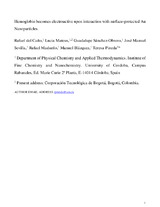Mostrar el registro sencillo del ítem
Hemoglobin becomes electroactive upon interaction with surface-protected Au nanoparticles
| dc.contributor.author | Del Caño-Ochoa, Rafael | |
| dc.contributor.author | Mateus, Lucía | |
| dc.contributor.author | Sánchez-Obrero, Guadalupe | |
| dc.contributor.author | Sevilla, José Manuel | |
| dc.contributor.author | Madueño, Rafael | |
| dc.contributor.author | Blázquez, Manuel | |
| dc.contributor.author | Pineda, Teresa | |
| dc.date.accessioned | 2024-02-05T07:32:19Z | |
| dc.date.available | 2024-02-05T07:32:19Z | |
| dc.date.issued | 2018 | |
| dc.identifier.uri | http://hdl.handle.net/10396/27082 | |
| dc.description.abstract | In this work, we report on the electrochemical behavior of bioconjugates prepared with gold nanoparticles (AuNP) capped with three different molecular layers (citrate anions, 6-mercaptopurine and ω-mercaptoundecanoic acid) and the protein hemoglobin (Hb). Freshly formed bioconjugates are deposited on a glassy carbon electrode and assayed for electroactivity. A pair of redox peaks with formal potential at −0.37 V is obtained, in contrast with the free Hb protein that is inactive on the glassy carbon substrate. The redox response is typical for quasi-reversible processes allowing the determination of the electron transfer rate constant for the three bioconjugates. Additional evidence of the structural integrity of protein upon forming the bioconjugate is obtained by monitoring the electrochemical response of the Hb heme Fe(III)/Fe(II) redox couple as a function of solution pH. Moreover, the Hb forming the protein corona around the AuNPs show good electrocatalytic activity for the reduction of hydrogen peroxide and oxygen. It has been found that only the first layer of Hb surrounding the AuNPs are electroactive, although some part of the second layer also contribute, pointing to the role of the AuNP in the electrochemical response. | es_ES |
| dc.format.mimetype | application/pdf | es_ES |
| dc.language.iso | eng | es_ES |
| dc.publisher | Elsevier | es_ES |
| dc.rights | https://creativecommons.org/licenses/by-nc-nd/4.0/ | es_ES |
| dc.source | Del Caño, R., Mateus, L., Sánchez-Obrero, G., Sevilla, J. M., Madueño, R., Blázquez, M., & Pineda, T. (2018). Hemoglobin becomes electroactive upon interaction with surface-protected AU nanoparticles. Talanta, 176, 667-673. https://doi.org/10.1016/j.talanta.2017.08.090 | es_ES |
| dc.subject | Hemoglobin | es_ES |
| dc.subject | Gold nanoparticles | es_ES |
| dc.subject | Protein corona | es_ES |
| dc.subject | Electron transfer | es_ES |
| dc.subject | Electroactivity | es_ES |
| dc.title | Hemoglobin becomes electroactive upon interaction with surface-protected Au nanoparticles | es_ES |
| dc.type | info:eu-repo/semantics/article | es_ES |
| dc.relation.publisherversion | http://dx.doi.org/10.1016/j.talanta.2017.08.090 | es_ES |
| dc.relation.projectID | Gobierno de España. CTQ2014-60227-R | es_ES |
| dc.relation.projectID | Gobierno de España. CTQ-2015–71955-REDT | es_ES |
| dc.relation.projectID | Junta de Andalucía. P10-FQM-6408 | es_ES |
| dc.rights.accessRights | info:eu-repo/semantics/openAccess | es_ES |

